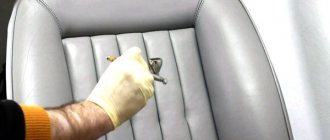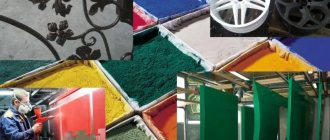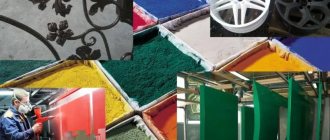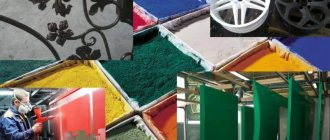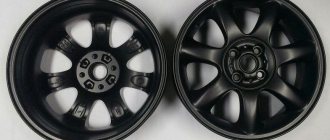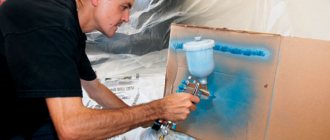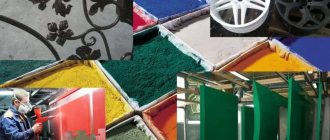To restore your car yourself, you need to take care of the interior. It is this part that suffers the most from use and needs high-quality painting. Here the driver spends a lot of time; his communication with the car consists of using interior parts. Therefore, they should always be kept in perfect order. To prevent car plastic paint from peeling off and fading prematurely, you need to follow the recommendations and purchase high-quality materials. Your car will again become more attractive and will be able to please you with wonderful emotions during operation.
The most difficult parts to paint are plastic parts. Here, the structural surface creates certain difficulties during restoration and does not allow the layer of old paint to be properly cleaned and new materials to be applied. In order for the plastic in the cabin to be as good as new, it must be looked after, treated with polishes and protective agents. If the appearance has already deteriorated, you will have to take on repair work. When working with a car interior, the most important stages are the correct choice of products for painting, as well as proper processing of the part before applying materials.
Choosing high-quality paint for car interior parts
Selecting suitable materials is one of the most difficult stages of completing a job. If you have never dealt with car paint issues, restoring plastic will be a rather complicated process for you. A car needs a professional approach at every stage, including when choosing products. You won't need a primer for salon elements, but specialized materials for painting will come in handy. You need to pay attention to the following points:
- special purpose for plastic - products can be used for car bumpers;
- the ability to paint structural surfaces, which is inherent in all auto paints for such tasks;
- manufacturer - choose well-known companies such as Motip or KUDO, you can use Polish Farbid;
- price - if the cost is too low, there is a possibility of purchasing a fake instead of the original;
- packaging form - the easiest way to work with aerosol options, since they do not require a compressor.
It is also worth acquiring rags, solvent and thinking about devices for hanging or laying plastic parts when applying paint and varnish products. Take care of everything in advance so that you don’t have to run around looking for scrap materials around the car when work begins. It is best to paint the interior elements of your car with products with a quality guarantee. In the store, when purchasing, you can ask for documents for the goods.
Chrome effect paints
Paintwork materials that create the effect of chrome or nickel plating are produced in cans and aerosol cans. According to experts, canned compounds are more difficult to apply, but the paint film is more similar to a natural metal coating. You can achieve perfect aesthetic similarity. It is better to paint a disc or headlight contour that you are restoring yourself using canned paint. Aerosol cans are purchased by beginners, who find it difficult to apply professional formulations in an even layer.
Aerosol cans are purchased by beginners, who find it difficult to apply professional formulations in an even layer.
Composition and characteristics
In terms of their component content, paints and varnishes differ due to the base. A binding film-forming base is added to the metal crushed to a powder state. Alkyd, acrylic, resin or nitrocellulose compounds help distribute the powder evenly. After drying, the base becomes transparent, metal particles are clearly visible, it is the powders that create a mirror-like, reflective surface.
Manufacturers offer a wide range of coatings with a metallic sheen for metal, plastic, and wood. Chrome paint comes in:
- Single-component, these are aerosol packages, nitro paint of the middle price category;
- Two-component based on acrylic or epoxy resin, it is characterized by increased resistance to moisture, dirt, and is not afraid of the effects of detergents (car shampoos, non-aggressive household chemicals).
To improve the visual effect, varnish is additionally used; it strengthens the film layer. Under the chrome paint the wood looks like metal. Heat-resistant powder coatings are diluted in a special way; they are more complex in structure. They form coatings closer to natural chrome plating - stable, bright.
To improve the visual effect, varnish is additionally used; it strengthens the film layer.
Dyes are available in different colors:
- Silver, simulating nickel, chrome;
- Gold ones with powder from colored alloys achieve a noble yellow tint;
- Dark - black, blue, other shades.
All paints for chrome plating are shiny, with good reflectivity, and form a protective film in the form of a mirror.
All paints for chrome plating are shiny, with good reflectivity, and form a protective film in the form of a mirror.
Advantages and disadvantages of spray cans
The main advantage of chrome paint in cans is that it can be applied without using a brush, your hands will remain clean. The main disadvantage is that the cylinder holds a small amount of paint and varnish.
Aerosols are used to hide minor defects on metal; powder paints perfectly mask rust.
Other advantages of chrome spray paint:
- The aerosol is ready for use; to paint, just remove the cap from the can and press the sprayer;
- Versatile, the mixtures are designed for coloring various materials, including plastic;
- No tools or equipment are required for work;
- An aerosol can is a sealed container, the paint is well preserved in the packaging and does not lose its original properties;
- Manufacturers offer a varied palette of colors, you can easily choose the desired shade;
- With aerosol spraying, the layer dries quickly;
- No special preparation is required for coating application.
Now about the disadvantages:
- It is difficult to process large areas;
- There may be problems with painting some types of polymers; with glossy plastics, the layer is scratched.
An aerosol can is a sealed container; the paint is well preserved in the packaging and does not lose its original properties.
Interior preparation and processing of old paint
The plastic in the car interior needs very high-quality processing. The specificity of painting materials is such that incorrect application will result in drips, color transitions and unpainted parts. All this causes certain difficulties. Interior plastic paint can adhere normally only if the part is first prepared. To do this, a fairly simple procedure is performed with the following procedure:
- The parts are removed from the car. This must be done carefully, as some plastic elements are very easy to damage. If we are talking about the panel and door cards, you can leave them in place, closing everything around.
- If the enamel is applied to a greasy and dirty surface, all the paint material will simply run off. So, to begin with, the plastic is degreased and cleaned of all kinds of contaminants.
- The next step is to sand off the old paint using water and fine-grit sandpaper. Use P 1500-2000 on a waterproof base and constantly feed water under the abrasive.
- Next, the interior is protected from paint getting on all kinds of elements, otherwise you will have to scrub them off later. To do this, use thin masking tape and film or newspapers to create protective screens.
- The last thing you should do is degrease the surface again and apply paint with gentle movements. This will help to quite easily maintain the evenness and quality of the plastic surface and restore freshness to the interior.
In order for the car to become beautiful again, you must apply the purchased materials efficiently and without errors during the work process. Otherwise, the paint will run off, will not dry, or will be very different in color. Remember also that when painting local plastic parts you will have to use the transition painting method. This is not possible using a spray can; professional equipment will be required. Interior plastic paint is sold not only in aerosol form, but this is the most convenient way to use it.
The best paints for rust and metal TOP 5
Let's consider paints that are used for application to various metal surfaces.
Epoxy enamel
This type of paint for various metal surfaces contains silicone resins. This coating is used to protect industrial pipelines. The main purpose of epoxy enamels is to protect metal structures from high temperatures. Enamel, due to the toxicity of the components that make up its composition, is used extremely rarely for household purposes. Also, this type of paint does not guarantee long-term protection against corrosive processes.
Oil paint
It contains natural oils, and drying oil is used as a binder. Due to its low resistance to temperature changes, the paint is intended for interior repair and finishing work - for example, for painting pipes located indoors. Oil paints do not provide the necessary anti-corrosion protection and this is why there is a limitation on their use as a material for external repair and finishing work. Also, this paint is characterized by a rapid loss of color brightness and cracking; it cannot withstand temperatures above 80 0C.
Alkyd paint
The main area of application of alkyd paints is the treatment of galvanized metal surfaces. Among all metal paints, alkyd paint has the best adhesive ability to the working surface. However, it is not able to withstand high temperatures and is not recommended for use on metal structures that become very hot, because the paint catches fire easily.
Hammer paint
This paint creates a rough, hammer-like finish with a metallic sheen. This effect is achieved thanks to the components contained in the paint - alkyds, aluminum powder, acrylic, epoxies. Semi-matte and glossy tones may also form. The first layer of paint acts as a primer, the next layer is anti-corrosion, and the third acts as an enamel. However, the paint is not suitable for metal objects heated above 150 0C.
Acrylic paint
This type of paint and varnish material has appeared on the market relatively recently, but has already gained popularity among buyers. And this is explained by a complex of functional characteristics. Acrylic paints provide the best long-lasting corrosion protection. They are suitable for interior and exterior finishing and repair work, because... do not fade or crack. The paint is immune to high temperatures - can withstand more than 120 0C. And this makes it possible to use acrylic paint for painting heating elements and highly heated objects. The paint is water-soluble and therefore non-toxic and non-flammable.
How much paint do you need to buy for interior parts?
Structural surfaces are unpredictable when applying paint and varnish products. In one car, a 400 ml bottle is enough to paint the entire interior, while in another, the same amount of material will be used for one large part. It is quite difficult to predict consumption. Each car is individual, but there are certain general criteria. When purchasing materials, consider the following features:
- You should not buy less than 400 ml, although you can find more compact packaging on store shelves;
- an aerosol can with a small volume will quickly lose normal pressure and will not help paint the interior efficiently;
- if you plan to paint plastic throughout the entire interior, you should immediately buy at least two cylinders with a reserve;
- before painting plastic, you will have to practice painting unnecessary car parts for experience;
- For normal results and successful car repairs, it is better to have more aerosol than you need.
Considering the affordable cost of cylinders, you can take products for cars with a small reserve. You can always find something else to paint in the car in order to get normal use of the vehicle’s interior. But to paint one small car part, you won’t need to buy too many paint products. Otherwise, the cost of your car restoration venture will be too high.
Coloring plastic at home
You can handle painting plastic materials yourself; this will greatly save your budget. Turning to professionals is very expensive. To carry out the work at home yourself, you will need to take care of your own safety by preparing protective equipment, also prepare all the necessary tools (listed above), and perform all stages of the work. They will be discussed in detail further.
You can handle painting plastic materials yourself; this will greatly save your budget.
Painting methods
The paint coating is available either in cans or in aerosols. Which option to choose depends on the size of the product and the experience of the person who will carry out the painting work.
- Spray cans are more appropriate for a small painting object; they are not difficult to work with, but before you start, you should try it out by spraying a little paint on an unnecessary surface, this will help you understand how best to spray to get the desired result. In general, the aerosol method will give a good, even coating. This method does not allow you to mix tones, and thus it will not be possible to apply clear color boundaries.
- The jar is larger in volume than the can, but storage in it is only possible for a short time. For this reason, it is often used for large volumes of work. It should also be taken into account that working with a brush is much more difficult and requires skill. Otherwise, unsightly traces of bristles and stains may remain on the product, the coating will be uneven and aesthetically look untidy.
Using a spray gun can make the process easier; a roller is rarely used. For a beginner, the spray can method would be more suitable.
Preparing plastic for painting
As mentioned earlier, you should carefully prepare the product before starting work in order to get an excellent result. This stage includes the following steps:
- To get rid of the previous cladding, you can use sandpaper, solvent, or a hair dryer.
- Get rid of contaminants.
- The product must be degreased using a solvent.
- Treat the product with antistatic agent.
- If required, use putty.
- To ensure good adhesion, the surface is treated with sandpaper no more than No. 180; after completing this stage, the object is cleaned and dried again.
- Degreasing is carried out again.
- Carry out priming work if required.
- Grind and clean again.
The product must be degreased using a solvent.
Plastic coloring technology
Having chosen the type of coloring agent, it is worth understanding the working method. The article will discuss two technologies: painting with a brush and applying with an aerosol.
They work with the brush, making wide, straight strokes, initially moving the brush softly, then pressing harder, so the coating will become thinner, and the finishing touch is also done softly to level it out. If everything is done correctly, then a one-time brush job is enough.
General recommendations:
- You don’t need to dip the whole brush, just the tip is enough;
- You should strive to make the layer as thin as possible by pressing on the bristles;
- Maintain the slope of the working position of the hand.
They work with a brush, making wide, straight strokes, initially moving the brush gently, then pressing harder.
The spray can process:
- Place the product on a flat surface, for example on a chair, mark the part to be painted with paper tape, cover nearby objects (with film, newspaper, paper);
- You must first shake the aerosol;
- There should be 20-30 centimeters left to the object;
- Spray the paint smoothly in one layer, holding the can straight;
- For complete coloring it is worth doing two or three layers;
- Between applying layers, wait the time indicated on the packaging until dry;
- After completing the work, remove the tape immediately.
After waiting for it to dry, you can coat the item with varnish to increase wear resistance. Acting in the same way as when painting.
Spray the paint smoothly in one layer, holding the can straight.
Paint for plastic is a great option to refresh old items and give them new life. The presence of a wide variety of colors allows you to come up with various solutions for decoration. Before painting the plastic, use all your imagination, take on board the tools necessary for this process, and as a result, you can perfectly decorate your home yourself.
Let's sum it up
Every car owner wants to make their vehicle more attractive. There are many ways you can implement this noble undertaking. But often methods involving professionals turn out to be too expensive. Therefore, potential customers of paint booths and service stations prefer to buy the necessary paint themselves and do the work themselves. This is much cheaper, but does not always give the desired results. It is important to choose the right methods and tools.
When working with plastic, you should protect the interior as much as possible from enamel and prepare the part for applying auto paint. Also, do not forget that there are quite a few brands on the market offering painting products in a variety of price segments. It is much easier to immediately buy good material and not overpay later for the restoration of poorly painted parts. It will be cheaper and more profitable in all aspects, and the owner of the vehicle will be able to show himself in taking care of his car.
Preparing the surface for painting
Plastic prepared for painting must be thoroughly washed, dried, and processed for high-quality paint application. Treatment of areas subject to intense mechanical stress during operation should be especially thorough.
Perform plastic processing in the following steps:
- Remove grease and oil deposits using a solvent.
- Treat with an antistatic agent. This is necessary to prevent dust particles from getting onto the surface to be painted.
- To eliminate defects, apply putty. Choose a special composition for plastic that is elastic.
- Level the surface with sandpaper and wet the surface.
- Dry the plastic. Then degrease again.
- To improve adhesion, prime using three thin coats. Leave until the primer dries.
- Treat with sandpaper.
Choosing a primer for plastic
For plastic, liquid acrylic-based enamel primer is used. This component dries quickly, creating a layer on the surface of the plastic that adheres well to the paint. Moreover, such a component is able to retain paint even when exposed to the sun and moisture. Finally, there is a method of applying such a primer by spraying. It is not only fast, but also very economical.
By the way! If, after the primer has dried, you treat it with sandpaper, the surface will acquire a matte color and will adhere to the paint even better.
Paint for plastic: choice
Spray paint is the best way to give plastic a new color. It fits perfectly, applies smoothly and very quickly. There are special types of paint created specifically for these polymer products. At the same time, the rapid drying is also noteworthy. The disadvantage of this paint is the inability to make clear boundaries without using masking tape, as well as the difficulty of painting small parts and mixing colors on the same surface.
Painting with universal or plastic acrylic enamel. Typically, delicate work is carried out in this way, or parts that do not require special attention are painted. The reason is that it takes longer to dry, during which the sticky surface can become dirty.
By the way! There is information on the Internet about the successful use of leather paint on plastic. It is applied after preliminary degreasing. At the same time, the coating lies smoothly and firmly.


